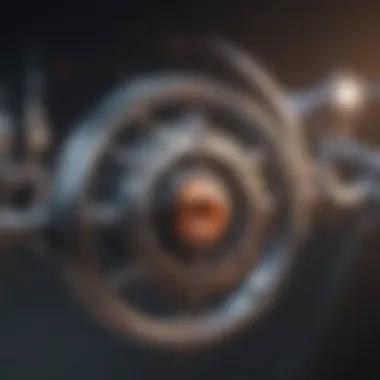Therapeutic Insights on Molnupiravir and Remdesivir


Intro
In the era of emerging infectious diseases, antiviral drugs like molnupiravir and remdesivir have stepped into the spotlight, offering hope against viral threats. These medications hold the potential to change the landscape of antiviral therapy, especially in the wake of COVID-19. Understanding their mechanisms, efficacy, and clinical use is not just important for healthcare professionals but also for anyone keen on the developments happening in the field of medicine.
Overview of Research Topic
Brief Background and Context
Molnupiravir and remdesivir are two antiviral agents that have garnered much attention in the clinical and research community. Molnupiravir, developed initially for treating influenza, has shown promise in curbing coronaviruses like SARS-CoV-2. On the other hand, remdesivir was originally designed to treat Ebola but has emerged as a key player in the fight against COVID-19, receiving emergency use authorization globally.
Emerging from the backdrop of viral pandemics, both drugs have drawn significant interest not just for their antiviral properties but also for their roles in shaping treatment protocols. Their introduction into clinical practice during a health crisis has set a precedent, underscoring the urgent need for effective antiviral strategies.
Importance in Current Scientific Landscape
Both drugs are pivotal in understanding and responding to viral outbreaks. Their distinct mechanisms contribute to the expanding arsenal of therapeutic options available to clinicians.
"In a world increasingly besieged by viral threats, the significance of antiviral agents like molnupiravir and remdesivir has never been more pronounced."
The relevance to current viral diseases extends beyond COVID-19. As researchers keep an eye on the potential for new viral threats, studying these medications provides valuable insights into how we can better prepare for future pandemics. Their clinical trials and subsequent real-world applications have paved the way for more comprehensive antiviral research.
Methodology
Research Design and Approach
The exploration of these two antiviral agents involves a multifaceted approach. Clinical studies often range from randomized control trials to observational studies designed to gather data across diverse demographics. This helps create a robust body of evidence regarding their efficacy, safety, and potential market adaptability. Furthermore, meta-analyses contribute to drawing conclusions from various studies, ensuring a more seamless understanding of their performance in different settings and populations.
Data Collection Techniques
Data collection for analyzing the therapeutic potential of molnupiravir and remdesivir involves multiple techniques, such as:
- Clinical Trials: These trials are structured to evaluate patient outcomes and side effects during treatment regimes.
- Observational Studies: Engaging in studies that track patients undergoing treatment in real-world settings can provide insight into everyday effectiveness and challenges.
- Meta-Analyses: By collating data from different trials, researchers can identify patterns and trends in drug performance across various populations and settings.
Understanding these methodologies helps navigate the complexities involved in evaluating these drugs’ therapeutic potential, enabling a clearer picture of their viability against viral infections.
Preface to Antiviral Therapies
Antiviral therapies have taken center stage in today's medical landscape. The advent of new viral infections, accompanied by a heightened global interconnectedness, makes understanding these therapies increasingly relevant. The implications stretch beyond mere treatment; they encompass public health strategies and the very fabric of healthcare systems. In this piece, we will explore the fundamental elements of antiviral agents, why they matter, and their broader context in our world.
Significance of Antivirals in Modern Medicine
The importance of antiviral medications cannot be overstated. These drugs are designed to target specific stages of viral replication, offering a way to halt infections in their tracks. For instance, antiviral therapy can drastically reduce hospitalizations and mortality rates, especially during pandemics.
We live in a time where the speed of viral mutation often outpaces our development of drugs. Therefore, constantly updating our antiviral arsenal is imperative. Here are key points emphasizing their significance:
- Rapid Action: Fast-acting antivirals can quickly manage outbreaks, reducing the burden on healthcare resources.
- Preventive Measures: Some antivirals serve as prophylactics, preventing infection in at-risk populations.
- Economic Benefits: Long-term savings on healthcare costs by reducing the need for hospitalization.
"In a world where new viruses emerge frequently, having a solid antiviral framework is analogous to having a sturdy umbrella in a rainstorm. You might not control the weather, but being prepared makes a difference."
These points highlight not just therapeutic potential but also an ethical responsibility to ensure access to antiviral treatments, as they can be lifesaving.
Overview of Viral Infections
Viral infections represent a significant challenge for healthcare worldwide. From common colds to more severe diseases like HIV/AIDS, viral pathogens exhibit an extensive range of impact. Understanding them is essential for adopting relevant antiviral strategies. Viral infections can be categorized into a variety of types:


- Acute Viral Infections: Often self-limited, these infections can lead to symptoms that resolve within days or weeks, but their impact can be considerable. Influenza is a prime example.
- Chronic Viral Infections: Infections such as hepatitis B can linger for years, leading to long-term complications like liver disease.
- Emerging Viral Infections: Outbreaks like COVID-19 underline the need for agile responses and innovative antiviral therapies.
Much of the global health efforts now hinge on understanding these viral infections better, paving the way for effective antiviral solutions that can help alleviate the burden on individuals and societies alike.
The Role of Molnupiravir
The significance of Molnupiravir in the realm of antiviral therapies cannot be overstated. As a novel oral antiviral, it was designed during the urgent times of the COVID-19 pandemic, arising from a need to combat a virus that proved to be a formidable foe worldwide. The emergence of variants and the urgent care required for patients spurred research. This medication provides a tangible response to the challenges posed by emerging viral threats, reflecting ongoing advancements in therapeutic protocols.
Mechanism of Action
Molnupiravir operates on a fundamental level, leveraging the mechanism of viral RNA replication. Through its unique action, it gets incorporated into viral RNA, leading to what is referred to as mutagenesis. In simpler terms, as the virus replicates, Molnupiravir effectively introduces errors into the genetic code. This results in a situation where the viral progeny are less viable, unable to propagate effectively. In essence, it derails the virus’s ability to thrive and replicate, which is crucial in the early stages of viral infection. The overall intent here is to not just halt the virus in its tracks, but to create a scenario where the immune system can regain the upper hand.
Clinical Trials and Efficacy
When it comes to practical application, the clinical trials for Molnupiravir were pivotal. Early studies showcased its efficacy against SARS-CoV-2, demonstrating a significant reduction in hospitalization rates among patients with mild to moderate COVID-19 who were at high risk for severe disease.
"In clinical settings, Molnupiravir has shown promise especially when administered within the first few days of symptom onset."
Among volunteers, the results indicated that treatment within the first five days significantly decreased complications. The data provided a basis for the drug's recommended use in similar viral infections, reaffirming its potential as a candidate when rapid intervention is still possible.
Regulatory Approvals and Guidelines
Regulatory bodies such as the U.S. Food and Drug Administration (FDA) moved relatively quickly to evaluate and approve Molnupiravir, which attests to its potential. The emergency use authorization (EUA) paved the way for its deployment in clinical settings. Guidelines have been established to assist healthcare providers regarding when and how to prescribe Molnupiravir effectively.
This includes recommendations for patient populations that stand to benefit most—those with underlying conditions that can compound the impact of viral infections. Each guideline emphasizes balancing efficacy with the timing of intervention, signifying that the drug's success doesn't merely hinge on its intrinsic properties but also on how and when it is utilized in the treatment regimen.
Potential Side Effects
While the merits of Molnupiravir paint a promising picture, it’s essential to acknowledge its side effects. Clinical trials have reported various adverse reactions, prominently including gastrointestinal disturbances such as nausea and diarrhea. Rare occurrences include anomalies in laboratory test results, which may need monitoring.
Understanding these potential side effects is vital for healthcare providers as they weigh the benefits against possible risks. Patient education on what to expect can ease concerns and clarify when to seek further medical advice. It’s critical to approach therapy holistically, considering both efficacy in curtailing viral load and the potential impacts on patient wellbeing.
Remdesivir: A Closer Look
Understanding remdesivir is critical in the landscape of antiviral therapies today. Initially created to combat the Ebola virus, this antiviral agent has shown promise against a range of RNA viruses, most notably SARS-CoV-2. Its mechanism of action exhibits significant bio-compatibility, allowing it to interrupt the viral replication cycle efficiently. As we delve into the specific elements of remdesivir, we unearth its importance in current treatment protocols and the broader implications for managing viral pandemics.
Mechanism of Action
Remdesivir functions primarily as a nucleotide analog. It mimics adenosine, a fundamental building block for RNA, and enters the viral replication process. Once incorporated into the growing viral RNA chain, remdesivir causes premature termination. This effectively prevents the virus from replicating and spreading within the host's cells. The binding affinity of remdesivir for viral RNA polymerase enhances its potency, making it a prime candidate for treating severe viral infections.
The importance of understanding this mechanism cannot be overstated. By comprehending how remdesivir disrupts the replication of the virus, healthcare professionals can tailor approaches to antiviral treatment that maximize patient outcomes. Furthermore, this knowledge pushes the boundary of research, highlighting potential avenues for enhancing its efficacy or developing similar agents through replication at a molecular level.
Efficacy in Clinical Contexts
Clinical trials involving remdesivir, particularly those conducted during the COVID-19 pandemic, have shown encouraging results, though interpretations vary.
- A study published in The New England Journal of Medicine illustrated that remdesivir reduced the time to recovery in COVID-19 patients significantly compared to a placebo group.
- The World Health Organization's Solidarity trial considered data from thousands of patients and suggested a modest effect on mortality rates.
- Overall, remdesivir’s impact on patients requiring supplemental oxygen or mechanical ventilation has been noteworthy.
However, contrasting results from different studies emphasize the need for context when discussing efficacy. Not all patients respond similarly to antiviral treatments, and factors like disease severity, timing of administration, and pre-existing health conditions play crucial roles.
Usage Guidelines and Approval Status
Remdesivir has gained extended emergency use authorization from several health authorities globally. In the United States, the Food and Drug Administration approved it for treating suspected or confirmed COVID-19 in hospitalized adults and pediatric patients. It is essential for clinicians to follow updated treatment guidelines from entities such as the Centers for Disease Control and Prevention and the National Institutes of Health.
Patients typically receive remdesivir through intravenous administration, with treatment often suggested over a five-day course. Ongoing monitoring during administration is crucial, considering varying recommendations on dosages based on the severity of the disease.


Adverse Reactions and Considerations
Remdesivir, like any medication, is not free from adverse effects. Most commonly reported reactions include:
- Nausea
- Elevated liver enzymes, which may indicate liver dysfunction
- Hypersensitivity reactions in rare instances
Given these potential risks, healthcare providers must conduct thorough assessments before starting treatment. While remdesivir is generally well-tolerated, monitoring patients for any adverse reactions during therapy remains paramount. This consideration ties back to understanding individual patient profiles, ensuring a tailored approach that maximizes benefits while minimizing risks.
"Knowledge is power, and in the realm of antiviral therapies, understanding the implications of drugs like remdesivir is vital for effective patient care."
As you can see, remdesivir plays a pivotal role in the ongoing battle against viral diseases. Its mechanism of action, clinical efficacy, usage guidelines, and side effects form a comprehensive picture that healthcare professionals must navigate as they seek to improve patient outcomes.
Comparative Analysis of Molnupiravir and Remdesivir
The comparative analysis of molnupiravir and remdesivir highlights critical distinctions that influence their effectiveness as antiviral agents in treating various viral infections. Understanding how these two drugs operate is pivotal, especially in the context of emerging viral threats such as SARS-CoV-2. This section seeks to elucidate their mechanistic differences, variations in efficacy related to viral load reduction, and optimal patient populations for each treatment. By examining these aspects, healthcare professionals can make informed decisions in their therapeutic approaches, aligning treatment protocols with the unique characteristics of each antiviral.
Mechanistic Differences
When it comes to their action mechanisms, molnupiravir and remdesivir are both nucleoside analogs, but they tread different paths.
Molnupiravir operates through a fascinating mechanism called viral mutation. It mimics the building blocks of RNA, but in a unique twist, it introduces errors during viral replication. This results in what is known as "error catastrophe"—a flooding of mutations that ultimately render the virus incapable of replication. The potential applications of this are broad, extending to a range of viruses, making it a candidate for use in various viral infections beyond COVID-19.
On the other hand, remdesivir uses a more targeted approach, interrupting the viral replication cycle. It embeds itself into the RNA chain during synthesis, leading to premature termination. This mechanism is essential for inhibiting viruses like coronaviruses and has garnered a spotlight in the treatment of COVID-19.
In essence, one is akin to throwing spanners in the works of viral replication, while the other cuts off the production line. This core difference shapes their respective use cases and effectiveness in combating specific viral targets.
Efficacy in Viral Load Reduction
The efficacy of molnupiravir and remdesivir in reducing viral load is a key consideration for treatment protocols. Clinical trials have provided some clarity, revealing that remdesivir tends to show a consistent ability to lower the time to recovery for patients with severe COVID-19. It notably shortens hospital stays and assists in managing symptoms effectively. Patients exhibit a marked decrease in viral load when administered this medication promptly after symptom onset.
Conversely, molnupiravir's efficacy lies in its oral administration, providing ease of use, especially in outpatient settings. Studies suggest that it may not be as effective in terms of rapid viral load reduction as remdesivir, particularly in critically ill patients. However, its value shines in the context of broader antiviral coverage, as it shows promise against other RNA viruses as well, which can be vital for public health considerations.
Patient Populations and Treatment Protocols
Understanding which patient populations benefit from each treatment is crucial.
- Remdesivir is often administered to hospitalized patients experiencing moderate to severe symptoms. Clinical guidelines advocate for its use within the first ten days of illness onset. The research underscores its significant benefits in cases where respiratory distress is a concern.
- Molnupiravir, meanwhile, is typically indicated for patients who are at high risk of severe outcomes but not yet in the hospital setting. It's particularly advantageous for those who may have difficulty accessing intravenous treatments, as the oral formulation simplifies administration in various healthcare environments.
Impact on Public Health
Antiviral treatments like molnupiravir and remdesivir have become pivotal in addressing public health challenges amid rising viral infections. This significance is further amplified by the ongoing struggles with diseases such as COVID-19, where effective treatments can potentially reduce mortality rates and alleviate the burden on healthcare systems. The very essence of public health lies in its ability to implement strategies that favor community well-being, and the access to antiviral therapies plays a critical role in achieving this.
Treatment Accessibility and Distribution
One of the essential facets of treatment accessibility is ensuring that antiviral medications reach the populations that need them most. It's easy to overlook, but the distribution channels for these drugs are crucial, particularly in under-resourced communities where the threat of viral infections looms large.
- Regional Disparities: Different regions often experience varying rates of viral infections. For instance, rural areas may lack adequate healthcare infrastructure, making it difficult for residents to obtain necessary medications.
- Logistics and Supply Chain: The logistics of delivering these drugs can become a maze, often hampered by supply chain issues. Disruptions in transportation can lead to medicine shortages in critical areas.
- Education and Awareness: Simple access is not the only hurdle. Communities must also be aware of their treatment options. Educational initiatives that inform patients about these antiviral treatments can aid in overcoming barriers to access.
Making sure that drugs like molnupiravir and remdesivir are not just available, but accessible, can lead to better health outcomes and reduce the strain on public health resources.
Cost-effectiveness and Healthcare Budgeting
Economics plays a massive role in the acceptance and integration of antiviral treatments into health care systems. In a world where every penny counts, determining cost-effectiveness shapes decisions made by policymakers and healthcare providers alike.


- Calculating Value: The effectiveness of a medication must be weighed against its cost. If a drug saves lives but is prohibitively expensive, its utility might be viewed with skepticism.
- Long-term Savings: Investing in antiviral treatments today might yield cost savings over time. For example, reducing hospital stays for patients infected with a virus has a direct impact not only on individual health but also on healthcare budgets.
- Funding Allocation: Budgeting for antiviral therapeutics must account for the broad spectrum of viral illnesses. This entails careful planning and allocation of funds to ensure adequate resources are devoted to developing and providing these critical medications.
"The long-term implications of investing wisely in antiviral treatments can echo throughout the healthcare landscape, affecting everything from patient outcomes to fiscal health of a nation."
Ultimately, the interplay between cost-effectiveness and treatment accessibility cannot be ignored. Governments and health organizations must strategize around these concepts to promote public health resilience.
As we forge ahead in combating infectious diseases, understanding the impacts of antiviral treatments on public health will provide crucial insights for tackling future challenges.
Future Perspectives
Understanding the future perspectives surrounding molnupiravir and remdesivir is critical. As the world continues to grapple with virus outbreaks, the development of antiviral therapies becomes ever more pressing. These two drugs, having shown promise in clinical environments, open up avenues for further research and potential applications, enhancing public health strategies.
Emerging Viral Threats and Antiviral Development
In an age rife with rapidly evolving viral threats, new antiviral agents must be at the forefront of our medical responses. Take, for instance, the ongoing emergence of variants of well-known viruses like SARS-CoV-2. With each new iteration, these pathogens display a capability to outmaneuver existing treatments. According to the World Health Organization, the constant mutation rates of viruses necessitate the refinement and development of antiviral drugs. This means that tools like molnupiravir and remdesivir, while groundbreaking, might only be the tip of the iceberg.
The importance of investing in the research of novel antivirals cannot be overstated. Health professionals, researchers, and pharmaceutical companies must collaborate towards developing drugs with robust efficacy against a wider array of viral infections. The basic mechanisms of these drugs also need to be studied closely, so their applications can be adapted, perhaps even combining them with other therapeutic strategies for synergistic effects.
"New antiviral therapies will not just be beneficial for treating infections, but could also be game-changers in preventing the spread of viruses globally."
Research Directions for Improved Antivirals
Looking ahead, there is a precipitated urgency to redefine research directions focused on enhancing the efficacy of antiviral treatments. Existing drugs like molnupiravir and remdesivir offer a foundation, but we must probe deeper into their pharmacological profiles. Areas ripe for exploration include:
- Mechanism Optimization: Understanding more about how these drugs interact with viral replication processes could lead to discovering improved analogs.
- Combination Therapies: Research into pairing these antivirals with existing drugs could enhance treatment efficacy, thus providing broader coverage against various viral strains.
- Longitudinal Studies: Observing long-term effects and outcomes of these medications on diverse populations will yield insights into developing personalized treatments.
Moreover, the need for clinical trials that encompass underrepresented communities must be highlighted. Ensuring that research includes a wide demographic will facilitate a better understanding of how different populations respond to antiviral drugs.
Culmination
In the ever-evolving landscape of antiviral treatments, the exploration of molnupiravir and remdesivir stands as a testament to medical innovation. These two agents have garnered attention not just for their effectiveness, but also for their implications in responding to global health crises. As we have unpacked throughout this article, the intricacies involved in the mechanisms, clinical trials, and eventual integration into treatment protocols reflect a multi-faceted approach to combating viral infections.
Summary of Findings
The investigation into molnupiravir and remdesivir reveals several key findings:
- Distinct Mechanisms: Molnupiravir operates through a mechanism that incorporates into the viral RNA, thereby causing mutations that impair viral replication. In contrast, remdesivir functions by interfering with RNA polymerase, effectively hindering the replication process of viruses such as SARS-CoV-2.
- Clinical Effectiveness: Clinical trials have highlighted the efficacy of both drugs, with molnupiravir showing promise in outpatient settings while remdesivir is more established in hospitalized patients. The comparative efficacy in reducing viral loads underscores the need for tailoring treatment plans to specific patient populations.
- Safety Profiles: While both treatments present potential side effects, monitoring and understanding these profiles is crucial. They can range from mild gastrointestinal symptoms to more severe reactions, emphasizing the need for vigilance in their administration.
Recommendations for Practice
Based on the insights gained from our review, several recommendations emerge for clinicians and healthcare providers:
- Tailored Treatment Protocols: Leverage the unique mechanisms of action to select appropriate antiviral therapy based on individual patient circumstances and healthcare setting.
- Continuous Monitoring and Reporting: Establish protocols for monitoring side effects rigorously. Timely reporting and data collection will enhance understanding of these treatments in real-world scenarios.
- Education and Training: Ensure healthcare professionals are well-versed in the indications and contraindications for both agents. Regular updates on evolving guidelines and emerging data can aid in optimizing patient care.
- Research Participation: Encourage involvement in ongoing clinical trials to advance the understanding of these antivirals' roles against emerging viral threats.
- For outpatients, consider using molnupiravir in conjunction with other supportive measures.
- In cases of hospitalization, remdesivir should be a front-line option while taking into account renal function.
Cited Works
Cited works serve as a vital resource for verifying claims within this discourse. They give weight to the analysis presented here, aligning it with established research while highlighting the nuances of antiviral medication development. Some key works in this area include:
- "The Efficacy of Remdesivir in COVID-19 Treatment" - Published in the New England Journal of Medicine.
- "Molnupiravir: A Novel Approach to Treating Viral Infections" - Journal of Antiviral Research.
- "Comparative Studies of Antivirals in Public Health" - Lancet Infectious Diseases.
These references guide professionals, students, and researchers through complex data and findings, offering a deeper dive into specific studies that detail both drugs’ impacts on various viral infections.
Further Reading
For those looking to expand their knowledge beyond this discussion, several resources are worth exploring. They include:
- World Health Organization (WHO) Guidelines: Updated recommendations on antiviral treatments and ongoing trials can be found on the WHO official website.
- Centers for Disease Control and Prevention (CDC): The CDC provides a comprehensive overview of antiviral therapies, including factsheets and updates on emerging antiviral agents.
- ResearchGate: A hub for academic articles where you can find firsthand accounts and ongoing research in the field of antiviral therapy.
In summary, the importance of references in this article transcends mere acknowledgment. They serve as the backbone that informs the exploration of molnupiravir and remdesivir's role in modern medicine, fostering a well-rounded discourse anchored in credible, peer-reviewed materials. As we continue to face viral threats, understanding the intricacies of these agents through reputable sources becomes increasingly essential.



